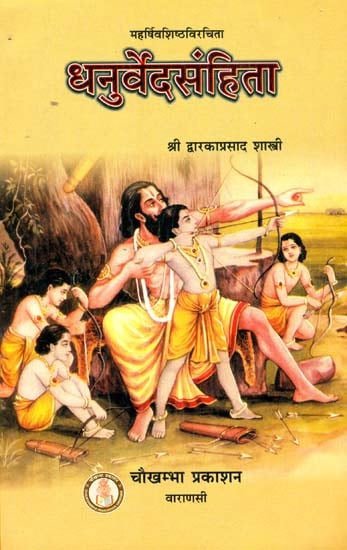Dhanurveda Samhita [sanskrit]
3,015 words
The Sanskrit text of the Dhanurveda-samhita attributed to Vasishtha. Dhanur Veda is a type of ancient India science whose roots date to the 2nd millenium BCE. It is counted among the Upavedas literature. This specific version of the Dhanurveda contains roughly 240 sections of Sanskrit text.
Verse 1.117
अथ श्रमक्रिया ।
क्रियाकलापान्वक्ष्यामि श्रमसाध्यांञ्छुचिष्मताम् ।
येषां विज्ञानमात्रेण सिद्धिर्भवति नान्यथा ॥ ११७ ॥
atha śramakriyā |
kriyākalāpānvakṣyāmi śramasādhyāṃñchuciṣmatām |
yeṣāṃ vijñānamātreṇa siddhirbhavati nānyathā || 117 ||
Note! The following is not a translation of the above verse, but merely an arbitrary extract of the English text.
Then the labor action. I shall now describe the activities and activities that are easy for those who are clean. Those whose perfection is attained by realization alone cannot be otherwise.
English translation by Hardayalu Swami (2001) Buy now!
Glossary of Sanskrit terms
Note: This extracts Sanskrit terms and links to English definitions from the glossary, based on an experimental segmentation of verse (1.117). Some terms could be superfluous while some might not be mentioned. Click on the word to show English definitions.
Atha, Shrama, Kriya, Kriyakalapa, Yah, Yat, Vijnana, Atra, Siddhi, Bhavati, Bhavat, Bhavant,
Analysis of Sanskrit grammar
Note: this is an experimental feature and only shows the first possible analysis of the Sanskrit text (Verse 1.117). If the system was successful in segmenting the sentence, you will see of which words it is made up of, generally consisting of Nouns, Pronouns, Verbs, Participles and Indeclinables. Click on the link to show all possible derivations of the word.
- Line 1: “atha śramakriyā ”
- atha -
-
atha (indeclinable)[indeclinable]
- śrama -
-
śrama (noun, masculine)[compound], [vocative single]
- kriyā -
-
kriyā (noun, feminine)[nominative single]
- Line 2: “kriyākalāpānvakṣyāmi śramasādhyāṃñchuciṣmatām ”
- kriyākalāpān -
-
kriyākalāpa (noun, masculine)[accusative plural]
- vakṣyāmi -
-
√vac (verb class 2)[future active first single]√vac (verb class 3)[future active first single]√vah (verb class 1)[future active first single]
- Cannot analyse śramasādhyāṃñchuciṣmatām
- Line 3: “yeṣāṃ vijñānamātreṇa siddhirbhavati nānyathā ”
- yeṣām -
-
ya (noun, masculine)[genitive plural]yaḥ (pronoun, masculine)[genitive plural]yat (pronoun, neuter)[genitive plural]
- vijñānam -
-
vijñāna (noun, neuter)[adverb], [nominative single], [accusative single]vijñānā (noun, feminine)[adverb]
- ātreṇa -
-
ātra (noun, neuter)[instrumental single]
- siddhir -
-
siddhi (noun, feminine)[nominative single]
- bhavati -
-
bhavatī (noun, feminine)[adverb], [vocative single]bhavat (noun, masculine)[locative single]bhavat (noun, neuter)[locative single]bhavant (pronoun, masculine)[locative single]bhavant (pronoun, neuter)[locative single]√bhū (verb class 1)[present active third single]
- nānya -
-
na (noun, neuter)[nominative plural], [vocative plural], [accusative plural]
- athā -
-
athā (indeclinable)[indeclinable]
Other editions:
Also see the following editions of the Sanskrit text or (alternative) English translations of the Verse 1.117
Dhanurveda Samhita (धनुर्वेदसंहिता)
by Hardayalu Swami (2001)
Publisher: Khemraj Shrikrishnadass
Buy now!
Vasistha’s Dhanurveda Samhita
by Purnima Ray (2023)
Publisher: Khemraj Shrikrishnadas; ISBN-10: 818670289X; ISBN-13: 9788186702895; 88 pages including 18 illustrations;
Buy now!
Dhanurveda Samhita (धनुर्वेदसंहिता) (संस्कृत एवं हिंदी अनुवाद)
by Shri Dwarka Prasad Shastri (2007)
Title: Dhanurveda Sanhita (Hindi translation); Publisher: Chaukhambha Prakashan, Varanasi; 84 pages including 11 illustrations; Author: महर्षि वशिष्ठ (Maharshi Vashistha); Foreword by Dr. Chakradhar Bijalwan.
Buy now!![Dhanurveda Samhita [sanskrit] - book cover](/uploads/a/Dhanurveda-Sanskrit.jpg)

